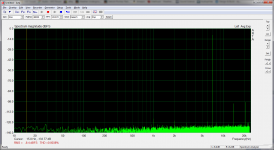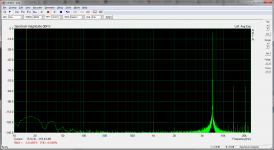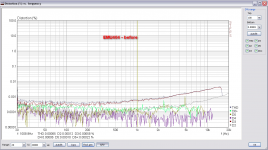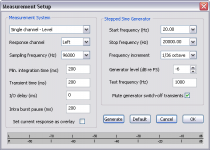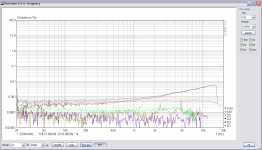Arny, what does it look like at, say, 7k and 1V?
diyAudio
That is about 0.18 volts
This is 1 volt:
http://www.diyaudio.com/forums/attachment.php?attachmentid=496633&stc=1&d=1438446642
The line level outputs are pseudo-balanced.
Attachments
Last edited:
And for Anders, here is the 10100Hz FFT.
Nice. Do you hit 'sweet spot' at -6 dB?
My Asus Xonar D2 performs best south of -12 dB , see below.
Loopback 10 kHz -12,5 dB
Loopback 10 kHz -11,5 dB
Some 'grass' could possibly be reduced. I have no view of the hardware since I remote this PC over VPN.
Distortion vs level shows the big jump...
Last edited:
Thanks, very nice. I have to find out if it works well with OS X.
I'm also looking out at E-MU Tracker Pre. Almost at the same price used. Here are RMMA stats:
RightMark Audio Analyzer test : E-MU Tracker Pre
Thanks, very nice. I have to find out if it works well with OS X.
I'm also looking out at E-MU Tracker Pre. Almost at the same price used. Here are RMMA stats:
RightMark Audio Analyzer test : E-MU Tracker Pre
Looks to me like a modernized 0404 USB, which would be a good thing.
Yeah, I'm still at sea trying to find a decent and reasonably priced USB unit that will do 192k.
The Emu tracker has a worse dac than the 0404.
Stocking up on second hand 0404's, just bought a 3rd one for 50 Euro. I am scheming to corner the European market, Hunt brother style ;-)
Stocking up on second hand 0404's, just bought a 3rd one for 50 Euro. I am scheming to corner the European market, Hunt brother style ;-)
USB and 192 has become a small world and most are used. I would go with an Emu 0404 for a general purpose ADDA. The tweaks shown on the other thread will take it a long way. Unfortunately the only way to get low noise floor above 20 KHz is the AK5394A based devices (no usb I know of today) so its to either an EMU 1212M (PCI or PCIE) or 1616M or 1812M + cardbus. That plus a used Dell E6410 with cardbus for $200-$300 and you have a very good mobile system. The next step up is the realm of the pro audio interfaces, Lynx or the like.
Here is my EMU0404 results, after changing 4 OPA left inputs + 4 OPA outputs with LME49720.
My emu has some pots modifies as described at posts 21 & 26.
There is no any significant improvement btw before and after to THD.
There is D2 improvement upper 5KHz that demonstrates much less distortion than default opa's.
Additional, a -3dB step capture was done.
At the least, setup of step is including.
My emu has some pots modifies as described at posts 21 & 26.
There is no any significant improvement btw before and after to THD.
There is D2 improvement upper 5KHz that demonstrates much less distortion than default opa's.
Additional, a -3dB step capture was done.
At the least, setup of step is including.
Attachments
Last edited:
Quick look at hybrid (2 different audio interfaces, one play, one record) approaches.
First off, the noise measurements for the ADC side of the M-Audio AP24192 with 50 ohm termination resistors are better than one might expect from loop-back measurements:
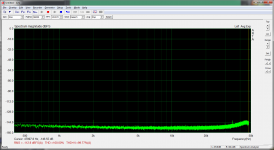
Then I tried using an inexpensive interface I saw on eBay as the DAC
"Finished SU0 XMOS U8 DAC+ AK4490 top asynchronous USB decoder with headphone"
Finished SU0 Xmos U8 DAC AK4490 Top Asynchronous USB Decoder with Headphone | eBay
in combination with the ADC in the AP24192:
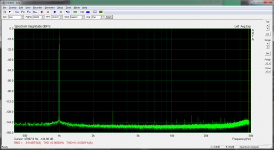
Vout from the DAC was 1.29 volts
First off, the noise measurements for the ADC side of the M-Audio AP24192 with 50 ohm termination resistors are better than one might expect from loop-back measurements:

Then I tried using an inexpensive interface I saw on eBay as the DAC
"Finished SU0 XMOS U8 DAC+ AK4490 top asynchronous USB decoder with headphone"
Finished SU0 Xmos U8 DAC AK4490 Top Asynchronous USB Decoder with Headphone | eBay
in combination with the ADC in the AP24192:

Vout from the DAC was 1.29 volts
Last edited:
Lemon, I suppose this is with unbalanced input. With balanced input, the measurements are bound to be better. Looking at the schematic, it is not difficult to see why this should be so. U15b performs a re-balancing act on unbalanced signals. In case of a true balanced signal with both signal lines swinging equally in opposite directions, U15 only functions as a DC reference.
In case of a unbalanced signal, U15B provides positive feedback to U9 so that the cold signal line becomes active and inverted. This ensures that whatever the input, balanced, unbalanced or balanced with one cold signal line, the ADC always get a balanced signal.
It works very well, but it comes at a penalty - most notably a rise in distortion with increasing frequency.
To make the EMU 0404 a better tool for unbalanced inputs, taking out U9 and U15b might work. It then has to be replaced by the kind of setup used in the 0404 to make a balanced output out of an unbalanced one, just a straight out inverting opamp. I haven't tried it and I doubt I will because of the time involved to do so.
In case of a unbalanced signal, U15B provides positive feedback to U9 so that the cold signal line becomes active and inverted. This ensures that whatever the input, balanced, unbalanced or balanced with one cold signal line, the ADC always get a balanced signal.
It works very well, but it comes at a penalty - most notably a rise in distortion with increasing frequency.
To make the EMU 0404 a better tool for unbalanced inputs, taking out U9 and U15b might work. It then has to be replaced by the kind of setup used in the 0404 to make a balanced output out of an unbalanced one, just a straight out inverting opamp. I haven't tried it and I doubt I will because of the time involved to do so.
Quick look at hybrid (2 different audio interfaces, one play, one record) approaches.
First off, the noise measurements for the ADC side of the M-Audio AP24192 with 50 ohm termination resistors are better than one might expect from loop-back measurements:
View attachment 497737
Then I tried using an inexpensive interface I saw on eBay as the DAC
"Finished SU0 XMOS U8 DAC+ AK4490 top asynchronous USB decoder with headphone"
Finished SU0 Xmos U8 DAC AK4490 Top Asynchronous USB Decoder with Headphone | eBay
in combination with the ADC in the AP24192:
View attachment 497738
Vout from the DAC was 1.29 volts
That's an interesting approach. I wonder if there are more here who tried this concept, i.e. using two different units each with strength in their separate role?
jan
That's an interesting approach. I wonder if there are more here who tried this concept, i.e. using two different units each with strength in their separate role?
jan
Right up front I can tell you that software like Arta that seems to be based on the odd idea that the DAC and the ADC are always in the same audio interface is not happy with this approach.
Interesting that Arta is limited this way, but the Audio Rightmark program is not.
I did what I did with Arta by using some other program to operate the audio interface with the DAC. I've done this using Audacity and it has worked out, but the samples I showed used the legacy software Cooledit Pro to drive the DAC, and only worked because I have my own inventory of .wav files with test signals in them.
Praxis permits seperate interfaces for adc and dac. It's very useful, especially for digital speakers and bluetooth. It's been essential for a lot of my work.
I think you can do similar with RMAA.
The AK4490 is one of the best if not the best performing dac chips available. Can you provide a link to the board?
Sent from my SGH-M919 using Tapatalk
I think you can do similar with RMAA.
The AK4490 is one of the best if not the best performing dac chips available. Can you provide a link to the board?
Sent from my SGH-M919 using Tapatalk
The AK4490 is one of the best if not the best performing DAC chips available.
This product includes the XMOS asynch USB interface that runs up to 192 KHz sampling.
Can you provide a link to the board?
It is actually a built up produce in an extruded aluminum case. I think that a board-only version has been available for a little less $$$.
Finished SU0 Xmos U8 DAC AK4490 Top Asynchronous USB Decoder with Headphone | eBay
The price is right, but the product is a bit artificially limited. It comes wired with the poorest option for good frequency response and this can't be changed without a soldering iron.
It starts clipping just below 1.5 volts RMS output. The headphone jack has an approximate 50 ohm source impedance which is high.
The output op amp is a JRC 5532 (socketed).
The out-of-box 44 KHz sampling FR is about 5 dB down @ 20 KHz. Some of the other numerous FR options are far flatter and could be made user selectable with some simple cheap internal jumpers.
Reminds me of Joao Martins' Editorial in AudioXpress 'We've only started with digital...': how long will hi end manus survive when their hi-$ items are made obsolete faster than smartphones by $ 70 units like this.
Jan
Jan
- Status
- Not open for further replies.
- Home
- Design & Build
- Equipment & Tools
- USB vs PCIe Sound Card for audio analysis
